

Sciatic nerve pain, aka sciatica, is a pain in the butt like no other. Your sciatic nerve is the longest nerve in your entire body. It runs from your lower spine to your hips and down the back of each leg all of the way to your feet, according to the Mayo Clinic. And when it gets ticked off, woah.
There are a lot of lovely ways to describe sciatic nerve pain: sharp, shooting, burning, electric and stabbing, among others. When you're in the throes of sciatic nerve pain, it can be impossible to think of anything but "How do I get my sciatic nerve to stop hurting?"
Video of the Day
Video of the Day
Stretches for Sciatic Nerve Pain
A lot of different factors can cause the condition (more on them below), but targeted sciatica exercises can relieve pain by loosening up any muscles or tissues that are pressing into and aggravating the nerve, says Bianca Beldini, DPT, a physical therapist, acupuncturist and owner of Sundala Wellness in New York.
That's why, when stretching for sciatic nerve pain, it's important to hit all of the possible culprits. "Pick one stretch that's dedicated to each area, like pigeon pose for the side butt, baby cobra to target the lower back and one hamstring stretch," she says.
To get you moving and feeling better, here are the 12 of the best sciatica stretches you can do.
Do each exercise on the side that's bothering you — and feel free to stretch the other side, too. It's never a bad idea to show your hip mobility some TLC.
Warning
These sciatica exercises should be gentle. Ease into them slowly, Beldini says, and if you’re feeling any pain, back out of the stretch until it no longer hurts, or scrap that one altogether. “Let pain be your guide.”
Move 1: Baby Cobra
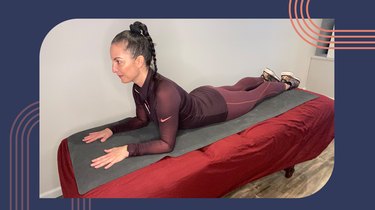
- Lie face-down with your forehead resting on the floor.
- Place your forearms flat on the floor and rise up onto your elbows.
- Hold for at least 40 seconds or as long as as it feels good.
Tip
Baby cobra is the ideal intro to sciatica stretches. It can help get spinal discs back into their rightful place, helping you move better through the following exercises, she says.
Move 2: Cobra
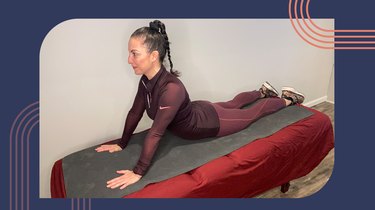
- Lie face-down with your forehead resting on the floor.
- Place your hands flat on the floor. Straighten your arms until they are fully extended and your torso is completely lifted off the floor
- Hold for at least 40 seconds or as long as as it feels good.
Tip
Full-on cobra builds on its baby to provide a deeper stretch. If you feel any compression in your lower back, you're likely dumping your body weight there.
Your fix: try pretending there's a string connecting the top of your head to the ceiling. Let it draw your torso up and away from your hips. You can also place a small pillow or rolled-up sweatshirt under your abdomen for support.
Move 3: Standing Pigeon
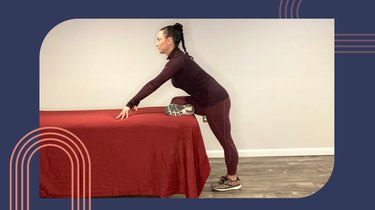
- Stand facing a bed, couch or bench that’s about hip height.
- Bend your right knee and rest the outside of your right calf on the surface. Your knee should point out to the right. Flex your foot so the bottom of your foot faces the left.
- Slowly bend forward at your hips and reach your arms onto the bed or couch.
- Walk your hands forward to deepen the stretch.
- Hold for at least 40 seconds or as long as as it feels good.
- Switch legs and repeat.
Move 4: Pigeon

- Start in a plank position.
- Step your left foot forward and place your calf on the floor. Put your left knee behind your left hand.
- Try to get your left shin as parallel to your body as possible. It’s OK if it’s more angled toward you.
- Square your hips so both face the floor. Relax your right leg.
- If your flexibility allows, walk your hands forward and lower your chest toward the floor in front of your bent leg.
- Hold for at least 40 seconds or as long as as it feels good.
- Switch legs and repeat.
Move 5: Figure 4
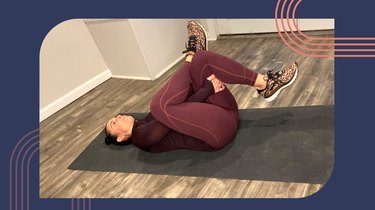
- Lie face-up. Cross your right foot over your left thigh and bend your left knee.
- Gently pull your left thigh toward your chest so that you feel a stretch in your right outer hip.
- Hold for at least 40 seconds or as long as as it feels good.
- Switch legs and repeat.
Tip
To deepen the stretch, lightly press your right knee away from you while you pull your left thigh toward you.
Move 6: Seated Hamstring Stretch

- Sit in a chair. Place your left foot on a yoga block or other small item. Your foot should rest a few inches off of the floor. Wrap a resistance band around your foot and grab the ends with both hands.
- Keeping your leg straight, gently lean forward and pull the band. You should feel a stretch along the back of your leg.
- Hold for at least 40 seconds or as long as as it feels good.
- Switch legs and repeat.
Tip
If this seated hamstring stretch flares up your symptoms flare, skip. You'll also want to avoid the next sciatica exercise, Beldini says. It's a deeper version of the same thing.
Move 7: Lying Hamstring Stretch
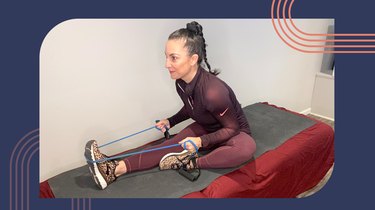
- Sit on the floor with your right leg extended and your left foot resting on the inside of your right thigh.
- Wrap a resistance band around your right foot and grab the ends with both hands.
- Keeping your leg straight and foot flexed, gently lean forward and pull the band. You should feel a stretch along the back of your leg.
- Hold for at least 40 seconds or as long as as it feels good.
- Switch legs and repeat.
Move 8: Standing Side Stretch

- Stand tall and hold a wall or object with your left hand for support.
- Cross your right leg in front your left. Both feet should be flat on the floor.
- Bend your upper body to the left and push your hips to the right. You should feel a stretch along the outside of your right hip.
- Hold for at least 40 seconds or as long as as it feels good.
- Switch legs and repeat.
Move 9: Double-Leg Lying Spinal Twist

- Lie face-up with your knees bent, feet flat on the floor and arms extended to the sides.
- Let your knees gently fall to the right. Keep your legs stacked in line with each other.
- Make sure your shoulder blades stay on the floor, even if that means your legs can’t fully reach the floor.
- Hold for at least 40 seconds or as long as as it feels good.
- Switch legs and repeat.
Tip
For a deeper stretch, press your bottom leg down with your top foot. Turning your head to face away from your legs will spread the stretch to your middle and upper back.
Move 10: Single-Leg Lying Spinal Twist

- Lie face-up with your right leg straight, left foot flat on the floor and your arms extended to your sides.
- Let your left leg gently fall across your right leg and to the floor.
- Make sure your shoulder blades stay on the floor, even if that means your left leg can’t fully reach the floor.
- To deepen the stretch, gently press on the left knee with your right hand.
- Hold for at least 40 seconds or as long as as it feels good.
- Switch legs and repeat.
Tip
For a deeper stretch, press your top knee with your opposite side's hand. Turning your head to face away from your legs will spread the stretch to your middle and upper back.
Move 11: Over-the-Bed Hip-Flexor Stretch

- Lie face-up on a bed or couch with your knees hanging off of the end.
- With both hands, pull your left knee toward your chest. Keep your back flat on the bed. You should feel the stretch in the front of your right hip.
- Hold for at least 40 seconds or as long as as it feels good.
- Switch legs and repeat.
Move 12: Seated Sciatic ‘Nerve Floss’

- Sit on the edge of a bed or couch with your knees hanging off of the end.
- Straighten your right leg in front of you and flex your foot. At the same time, extend your neck back to look up at the ceiling. Pause.
- Slowly bend your right leg and lower your foot back down. Meanwhile, drop your chin to your chest. Pause.
- Continue for at least 40 seconds or as long as as it feels good.
- Switch legs and repeat.
What Causes Sciatic Nerve Pain?
When the sciatic nerve's root — where it starts at your spine — gets irritated, inflamed, squeezed or pinched, pain, tingling and numbness to radiate down the nerve. Symptoms typically hit the butt and/or leg on just one side of the body, Beldini says.
True, text-book sciatica always involves the back. Common causes of sciatic nerve pain include back injuries like a herniated disc, spinal stenosis (a narrowing of the spinal canal), osteoarthritis-related bone spurs and anything else that puts pressure on the nerve, according to the Cleveland Clinic.
With piriformis syndrome — a condition in which the butt's piriformis muscle gets inflamed — it can press on the sciatic nerve and cause sciatica-like pain. Unlike true sciatica, the spine's not involved. But the symptoms and treatment options for the syndrome are the same.
According to the U.S. National Library of Medicine, piriformis syndrome is uncommon, but affects more women than men. Common causes include injury and overuse during repetitive activities like running, playing sports, climbing stairs and even sitting for long periods of time.
How Long Does It Take for Sciatic Nerve Pain to Go Away?
Give it at six weeks of at-home treatments like icing, OTC pain relievers and sciatica stretches, per the Cleveland Clinic. If, after that time, the pain hasn't mostly cleared up, you may need professional help.
Treatments for severe sciatica include prescription muscle relaxants, physical therapy, spinal corticosteroid (aka steroid) injections, massage, acupuncture and, as a last resort, sciatica surgery to remove whatever is pressing on the nerve.
When it comes down to it, if your pain affects your quality of life, it's important to talk to your primary care doctor and they can refer you to a specialist. They may do scans, like an MRI and CT, to learn more about what's causing your pain and what treatments can best help you.
Was this article helpful?
150 Characters Max
0/150
Thank you for sharing!
Thank you for your feedback!